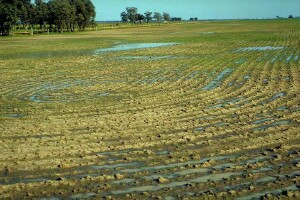Waterlogging
Crusting | Waterlogging | Trafficability | Compaction | Cultivation/Tillage for Broadacre Cropping
| What is waterlogging? In some regions of south-eastern Australia high winter rainfall, combined with poor soil structure regularly causes severe waterlogging damage to plant growth. In south-west Victoria, waterlogging is the major constraint to soil health and crop yields, and it inhibits the development and expansion of a reliable and profitable grains industry Winter waterlogging is the main limitation to grain production in the high rainfall zone of south eastern Australia (> 550 mm per year). What causes waterlogging? Waterlogging is a consequence of the high clay content and low permeability of subsoils, resulting in the development of perched watertables during the long cool growing season. Waterlogging is generally attributed to dense and sodic subsoils which are common in both south eastern Australia and western Australia. Following rainfall, perched watertables develop close to the soil surface due to hardpans or dense subsoils restricting profile drainage. In southern Australia, this is most prevalent in the wet winter months of June-August, when temperatures and evaporation rates are low. |  |
What is the effect of waterlogging?
The effects of waterlogging on winter crops is usually seen as reduced growth and chlorosis of older leaves (Ellington 1986). Under waterlogged conditions, aeration of the soil is reduced, and loss of nitrogen by identification and leaching is increased (Webster et al. 1986; Belford et al. 1992). The inhibition of gas exchange within the root zone also has the potential to damage plant roots, resulting in restricted water and nutrient uptake by the plant. Chlorosis of older leaves is observed due to poor root development and the consequential slow uptake of nitrogen by crop roots from the anaerobic soil (Belford et al. 1992).
The effect of waterlogging on final crop yield depends on the frequency and duration of the waterlogging event(s) and timing with respect to the growth stage of the crop (Johnston 1999). Published literature indicates that waterlogging has the greatest detrimental effect on crop yields when it occurs at germination or in the early vegetative stages (Watson et al. 1976; Cannell et al. 1980).
The vulnerability of many grain legume, oil-seed and cereal crops to waterlogging early in the growing season, limits crop options available to growers in many parts of southern Australia. Lack of confidence in growing high returning grain crops not only reduces potential income, it also limits crop choices for use as a N input crop and/or crop to break the cereal disease cycle.
Without some form of drainage, it can lead to crop failures on both flat and sloping ground.
Where do waterlogged soils commonly occur?
Common in the high rainfall areas (> 550 mm per year) of south eastern Australia. Waterlogging is most prevalent in south west Victoria.
How can I fix waterlogged soils?
Since 1996, raised bed systems have revitalised the broad-acre cropping industry in the high rainfall zone of south-west Victoria due to increases in yields and the reduced risk of low production or crop failure in wet years. In addition, the compulsory controlled traffic practices associated with raised bed systems can lead to improvements in the health of the soils in wet and dry periods as machinery wheels are confined to the drainage furrows. The raised beds systems were developed in a partnership between the former DPI and Southern Farming Systems (external link).
Underground drainage systems including conventional mole and gravel mole systems, in combination with surface drainage, also have the potential to significantly increase grain and pasture production in many of the areas prone to waterlogging (Johnston 1999).


